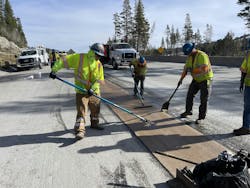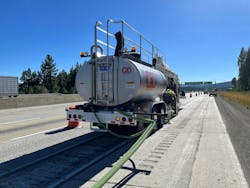Wheel Rut Headache
By Jessica Porter, Contributing Author
The 2022-23 winter season in the Sierra Nevada mountains saw the second highest amount of snowfall in the past 77 years, as recorded by the UC Berkeley Central Sierra Snow Laboratory.
With a total snowfall of approximately 700 inches — nearly 60 feet — the California Department of Transportation (Caltrans) worked hard this past year to ensure that the roadways remained in good condition and could handle this winter season.
Because of the area’s high average snowfall, it’s common to experience days during which tire chains are required for vehicles in the winter and early spring.
Interstate 80, which runs from San Francisco to north of Lake Tahoe, Cali., has an 80% truck volume. The 2022-23 winter season called for a higher-than-average number of days with tire chain requirements, which led to significant wheel rutting on the road.
“In the winter, they put chains on semi-trucks, and those chains eat the roadway up,” said Q&D Construction Project Manager/Estimator Marc Leone. “The paths where the wheels travel become deep channels, or wheel ruts.”
Caltrans regularly reviews roadways to determine maintenance plans.
“It comes down to the winter we had, including the amount of snowfall and time with chain restrictions in winter and spring. Knowing how big of a season it was, we knew that we need to go look,” said Jeremy Linder, the public information officer for Caltrans District 3.
Motorists also were complaining about the road conditions after the heavy winter snowfall.
“When you were in the slow lanes, where the majority of trucks ride, it was so bad you could take your hands off the steering wheel,” said Leone.
As a result, Caltrans issued an emergency contract to repair the ruts before the 2023-24 winter season.
Caltrans considered repairs like full-width polymer overlay, unbonded concrete overlay, full-width profile grinding, and full-lane replacement.
However, it was decided that wheel rut repair was the best option to quickly address the significant number of miles with wheel ruts and avoid needing more costly repairs down the line.
“Rut repair is a strategy that can repair a significant amount of wheel ruts in a short amount of time,” said Senior Engineer for Caltrans District 3 Martin Clark. “Wheel rut repair is our current chosen method for this kind of maintenance.”
Wheel rut repair is an effective, less disruptive, and cost-effective solution that extends the life of a pavement.
“Rather than profile grinding the whole roadway down and doing it again in three years, they cut out the wheel rut and put polymer back in,” Leone said. “That lasts five to seven years. The chains are very abrasive so the Kwik Bond Polymer will eventually wear out.”
However, wheel rut repair is only an option when the concrete pavement is structurally in good condition. Because I-80 was structurally sound, wheel rut repair was the best choice.
“When the concrete slab is in good condition, wheel rut repair is a more economic choice compared to replacement if the majority of the road is still drivable,” Linder said.
Caltrans issued five contracts to address 163 lane miles of pavement with wheel ruts stretching from Colfax, Calif., to the border of California and Nevada along I-80.
Wheel ruts on I-80 vary in size from 1.5 to 2 feet wide and average 2 inches deep but range from 1 to 3 inches deep.
Work began in September 2023 and will continue in 2024 after the winter season. The project scope includes polymer inlay and slab replacement.
The more than $15 million contract enabled Q&D Construction to perform 34 miles of wheel rut repair from the I-80/State Highway 267 interchange in Truckee, Calif., to the state border with Nevada.
To conduct the work, a 3.5-foot-wide diamond grinder cut the wheel rut with an edge depth that is approximately ¾ inch. The ruts were shot blasted, providing proper surface preparation to adhere to the polymer system.
Then, a layer of methacrylate bonded the polymer and sealed the surface cracks, and the polymer concrete overlay was placed in the wheel rut.
The polymer concrete overlay was field batched by volumetric trucks and dispersed from the trucks into the ruts. A modified skidsteer with a screed attachment smoothed the polymer concrete in the ruts to the correct texture.
This process brings the surface back to a smoothness that is in line with its original tolerance. Q&D Construction performed a light profile grind at the end to ensure smoothness. In addition to wheel rut repair, the project consisted of panel replacements and joint sealing.
To complete the work in a single week on time and with minimal disruption to traffic, Q&D Construction worked 24-hours per day to perform grinding on Sunday, Monday, Tuesday, and Wednesday night and inserted the polymer Monday, Tuesday, Wednesday and Thursday morning. The roadway reopened Friday at noon for weekend traffic.
“Wheel rutting is a recurring problem for owner agencies, particularly in mountainous areas like the Sierra Nevada mountains,” said Nick Davis, director of technical services for the International Grooving and Grinding Association (IGGA). “The trick is getting the right methods and materials that will hold up to future traffic and weather conditions.”
The total cost for the five contracts on I-80 was $69.2 million. As work progressed throughout the fall of 2023, Caltrans updated the public on social media.
“Comments from the traveling public are in support because they were tired of traveling over the roads,” Clark said. “Getting it back to smoothness is what the public is most excited about.”
By choosing wheel rut repair to address the damage incurred by tire chains during the harsh 2022-23 winter season, Caltrans provided motorists a smoother roadway with minimal traffic interruptions—and used less taxpayer funds by preserving the pavement instead of reconstructing the roadway. RB


